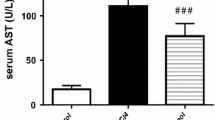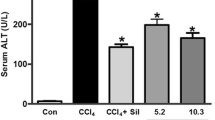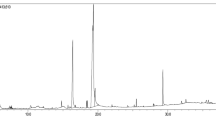Abstract
Currently, hepatic injury due to environmental pollutants extremely threatens human health and elicits great concern. Hence, there is a high global interest to find natural novel formulation products with potent hepatoprotective activity to combat liver disease. Hence, we evaluated the protective or therapeutic effect of hesperidin (HSP) and taurine (TAU), individually and in combination, on carbon tetrachloride (CCl4)-induced acute hepatic injury in rats. The pre- or posttreatment by HSP and/or TAU significantly depressed CCl4-induced elevation of alanine aminotransferase, alkaline phosphatase, aspartate aminotransferase, gamma-glutamyl transferase, total bilirubin, direct bilirubin, indirect bilirubin, malondialdehyde, globulins (α1, α2, β, and γ), albumin/globulin ratio, triglycerides, total cholesterol, high-density lipoprotein cholesterol, very low-density lipoprotein cholesterol, low-density lipoprotein cholesterol, nitric oxide, and myeloperoxidase levels. Also, the pre- or posttreatment by HSP and/or TAU significantly minimized CCl4-induced reduction of superoxide dismutase, catalase, reduced glutathione, and albumin concentrations. Furthermore, the protective or therapeutic administration of HSP and/or TAU markedly restored the CCl4-induced altered hepatic architecture, depleted glycogen, and DNA contents. Notably, alleviating CCl4-induced hepatotoxicity was more prominent in the protective groups than the therapeutic groups. More importantly, most of biochemical and histopathological parameters of HSP+TAU did not significantly differ from those of separate TAU or HSP neither before nor after CCl4 exposure. Conclusively, HSP or TAU could be candidate protective agents against CCl4 hepatotoxic impacts but the combination of both bioactive offers only a limited synergistic effect.

Graphical abstract





Similar content being viewed by others

References
Abd-Elhakim YM, El Bohi KM, Hassan SK, El Sayed S, Abd-Elmotal SM (2018) Palliative effects of Moringa olifera ethanolic extract on hemato-immunologic impacts of melamine in rats. Food Chem Toxicol 114:1–10
Abd-Elhakim YM, Moustafa GG, Hashem MM, Ali HA, Abo-EL-Sooud K, El-Metwally AE (2019) Influence of the long-term exposure to tartrazine and chlorophyll on the fibrogenic signalling pathway in liver and kidney of rats: the expression patterns of collagen 1-α, TGFβ-1, fibronectin, and caspase-3 genes. Environ Sci Pollut Res 26:12368–12378
Abd-Elhakim YM, El-Sharkawy NI, Mohammed HH, Ebraheim LLM, Shalaby MA (2020) Camel milk rescues neurotoxic impairments induced by fenpropathrin via regulating oxidative stress, apoptotic, and inflammatory events in the brain of rats. Food Chem Toxicol 135:111055. https://doi.org/10.1016/j.fct.2019.111055
Abdel-Moneim AM, Al-Kahtani MA, El-Kersh MA, Al-Omair MA (2015) Free radical-scavenging, anti-inflammatory/anti-fibrotic and hepatoprotective actions of taurine and silymarin against CCl4 induced rat liver damage. PLoS One 10:e0144509
Abo-EL-Sooud K, Hashem MM, Badr YA, Eleiwa MM, Gab-Allaha AQ, Abd-Elhakim YM, Bahy-EL-Dien A (2018) Assessment of hepato-renal damage and genotoxicity induced by long-term exposure to five permitted food additives in rats. Environ Sci Pollut Res 25:26341–26350
Adewale O, Adekeye A, Akintayo C, Onikanni A, Sabiu S (2014) Carbon tetrachloride (CCl4)-induced hepatic damage in experimental Sprague Dawley rats: antioxidant potential of Xylopia aethiopica. J Phytopharmacol 3:118–123
Aebi H (1984) [13] Catalase in vitro. In: Methods in enzymology, vol 105. Elsevier, pp 121–126
Ahmadi SA, Boroumand M-A, Gouhari MK, Tajik P, Dibaj S-M (2008) The impact of low serum triglyceride on LDL-cholesterol estimation
Bancroft JD, Floyd AD, Suvarna SK (2013) Bancroft’s theory and practice of histological techniques
Beutler E (1963) Improved method for the determination of blood glutathione. J Lab Clin Med 61:882–888
Biasetti M, Dawson R Jr (2002) Effects of sulfur containing amino acids on iron and nitric oxide stimulated catecholamine oxidation. Amino Acids 22:351–368
Boşgelmez İİ, Söylemezoğlu T, Güvendik G (2008) The protective and antidotal effects of taurine on hexavalent chromium-induced oxidative stress in mice liver tissue. Biol Trace Elem Res 125:46
Brosnan JT, Brosnan ME (2006) The sulfur-containing amino acids: an overview. J Nutr 136:1636S–1640S
Bucolo G, David H (1973) Quantitative determination of serum triglycerides by the use of enzymes. Clin Chem 19:476–482
Çetin A, Çiftçi O, Otlu A (2016) Protective effect of hesperidin on oxidative and histological liver damage following carbon tetrachloride administration in Wistar rats. Arch Med Sci 12:486–493. https://doi.org/10.5114/aoms.2015.49484
Chao-Jen L, Chun-Ching C, Yi-Chen C, Mu-Lin C, Tsai-Ching H, Bor-Show T (2015) Taurine attenuates hepatic inflammation in chronic alcohol-fed rats through inhibition of TLR4/MyD88 signaling. J Med Food 18:1291–1298. https://doi.org/10.1089/jmf.2014.3408
Chiueh CC, Rauhala P (1999) The redox pathway of S-nitrosoglutathione, glutathione and nitric oxide in cell to neuron communications. Free Radic Res 31:641–650
Choi I-Y, Kim SJ, Jeong HJ, Park SH, Song YS, Lee JH, Kang TH, Park JH, Hwang GS, Lee EJ, Hong SH, Kim HM, Um JY (2007) Hesperidin inhibits expression of hypoxia inducible factor-1 alpha and inflammatory cytokine production from mast cells. Mol Cell Biochem 305:153–161
Dassarma B, Samanta S, Nandi D (2017) Toxicokinetics of carbontetrachloride (CCl4) exposure on hepatorenal system. Eur J Biomed Pharm Sci 4:520–525
Doumas B, Biggs H (1972) Determination of serum globulin. In: Cooper (ed) Standard methods of clinical chemistry, vol 7, New York, Academic Press
Doumas BT, Bayse DD, Carter RJ, Peters T, Schaffer R (1981) A candidate reference method for determination of total protein in serum. I. Development and validation. Clin Chem 27:1642–1650
El-Hakim YMA, Mohamed WA, El-Metwally AE (2018) Spirulina platensis attenuates furan reprotoxicity by regulating oxidative stress, inflammation, and apoptosis in testis of rats. Ecotoxicol Environ Saf 161:25–33
El-Sayed WM, Al-Kahtani MA, Abdel-Moneim AM (2011) Prophylactic and therapeutic effects of taurine against aluminum-induced acute hepatotoxicity in mice. J Hazard Mater 192:880–886
Flora SJ, Chouhan S, Kannan GM, Mittal M, Swarnkar H (2008) Combined administration of taurine and monoisoamyl DMSA protects arsenic induced oxidative injury in rats. Oxidative Med Cell Longev 1:39–45
Friedman SL (2000) Molecular regulation of hepatic fibrosis, an integrated cellular response to tissue injury. J Biol Chem 275:2247–2250
Gornal A, Bardawill C, David M (1949) Protein-Biuret colorimetric method. J Biol Chem 177:751
Habauzit V et al (2011) Differential effects of two citrus flavanones on bone quality in senescent male rats in relation to their bioavailability and metabolism. Bone 49:1108–1116
Halim ABTAA, Nur NM, El-Agamy E-S, Ibrahim A (2017) Protective effect of hesperidin (HDN) on carbon tetrachloride (CCl4)-induced hepatic toxicity in male albino rats. Int J Contemp Res Rev 8
Heerspink W, Hafkenscheid J, Siepel H, van der Ven-Jongekryg J, Dijt C (1980) Temperature-converting factors for enzymes: comparison of methods. Enzyme 25:333–341
Huxtable R (1992) Physiological actions of taurine. Physiol Rev 72:101–163
Hwang D, Wang L, Cheng H (1998) Effect of taurine on toxicity of copper in rats. Food Chem Toxicol 36:239–244
Hwang D, Hour J, Cheng H (2000) Effect of taurine on toxicity of oxidized fish oil in rats. Food Chem Toxicol 38:585–591
Hwang YP, Choi CY, Chung YC, Jeon SS, Jeong HG (2007) Protective effects of puerarin on carbon tetrachloride-induced hepatotoxicity. Arch Pharm Res 30:1309
Jacobsen JG, Smith L (1968) Biochemistry and physiology of taurine and taurine derivatives. Physiol Rev 48:424–511
Joo Y-C, Ko YJ, You SK, Shin SK, Hyeon JE, Musaad AS, Han SO (2018) Creating a new pathway in Corynebacterium glutamicum for the production of taurine as a food additive. J Agric Food Chem 66:13454–13463
Kaffarnik H, Schneider J, Schubotz R, Hausmann L, Mühlfellner G, Mühlfellner O, Zöfel P (1978) Plasma lipids, triglyceride/fatty acid pattern, and plasma insulin in fasted healthy volunteers during continuous ingestion of ethanol: influence of lipolysis inhibited by nicotinic acid. Atherosclerosis 29:1–7
Kamata K, Sugiura M, Kojima S, Kasuya Y (1996) Restoration of endothelium-dependent relaxation in both hypercholesterolemia and diabetes by chronic taurine. Eur J Pharmacol 303:47–53
Kaplan JR, Manuck SB, Adams MR, Weingand KW, Clarkson TB (1987) Inhibition of coronary atherosclerosis by propranolol in behaviorally predisposed monkeys fed an atherogenic diet. Circulation 76:1364–1372
Kim T-W, Lee DR, Choi BK, Kang HK, Jung JY, Lim SW, Yang SH, Suh JW (2016) Hepatoprotective effects of polymethoxyflavones against acute and chronic carbon tetrachloride intoxication. Food Chem Toxicol 91:91–99
Kind P, King E (1954) Estimation of plasma phosphatase by determination of hydrolysed phenol with amino-antipyrine. J Clin Pathol 7:322
Kuo D-H et al (2010) Protective effect of Pracparatum mungo extract on carbon tetrachloride-induced hepatotoxicity in rats. Food Chem 123:1007–1012
Lee K-H, Yeh M-H, Kao S-T, Hung C-M, Liu C-J, Huang Y-Y, Yeh C-C (2010) The inhibitory effect of hesperidin on tumor cell invasiveness occurs via suppression of activator protein 1 and nuclear factor-kappaB in human hepatocellular carcinoma cells. Toxicol Lett 194:42–49
Li L, Li W, Kim Y-h, Lee YW (2013) Chlorella vulgaris extract ameliorates carbon tetrachloride-induced acute hepatic injury in mice. Exp Toxicol Pathol 65:73–80
Mantile M, Allen A (1978) A colorimetric assay for glycoproteins based on the periodic acid/Schiff stain. Portland Press Limited
Militante J, Lombardini J (2002) Treatment of hypertension with oral taurine: experimental and clinical studies. Amino Acids 23:381–393
Militante J, Lombardini JB (2004a) Age-related retinal degeneration in animal models of aging: possible involvement of taurine deficiency and oxidative stress. Neurochem Res 29:151–160
Militante JD, Lombardini JB (2004b) Dietary taurine supplementation: hypolipidemic and antiatherogenic effects. Nutr Res 24:787–801
Mohamed WA, Abd-Elhakim YM, Farouk SM (2016) Protective effects of ethanolic extract of rosemary against lead-induced hepato-renal damage in rabbits. Exp Toxicol Pathol 68:451–461
Mohamed WA, Abd-Elhakim YM, Ismail SA (2019) Involvement of the anti-inflammatory, anti-apoptotic, and anti-secretory activity of bee venom in its therapeutic effects on acetylsalicylic acid-induced gastric ulceration in rats. Toxicology 419:11–23
Montgomery H, Dymock JF (1961) Determination of nitrite in water vol 86. Royal Soc Chemistry Thomas Graham House, Science Park, Milton Rd, Cambridge Cb4 0wf, Cambs, England
Mosqueda-Solís A, Sánchez J, Portillo MP, Palou A, Picó C (2018a) Combination of capsaicin and hesperidin reduces the effectiveness of each compound to decrease the adipocyte size and to induce browning features in adipose tissue of Western diet fed rats. J Agric Food Chem 66:9679–9689
Mosqueda-Solís A, Sánchez J, Reynés B, Palou M, Portillo MP, Palou A, Picó C (2018b) Hesperidin and capsaicin, but not the combination, prevent hepatic steatosis and other metabolic syndrome-related alterations in western diet-fed rats. Sci Rep 8:15100
Nakashima T, Taniko T, Kuriyama K (1982) Therapeutic effect of taurine administration on carbon tetrachloride-induced hepatic injury. Jpn J Pharmacol 32:583–589
Natarajan SK, Thomas S, Ramamoorthy P, Basivireddy J, Pulimood AB, Ramachandran A, Balasubramanian KA (2006) Oxidative stress in the development of liver cirrhosis: a comparison of two different experimental models. J Gastroenterol Hepatol 21:947–957. https://doi.org/10.1111/j.1440-1746.2006.04231.x
Nichols LA, Jackson DE, Manthey JA, Shukla SD, Holland LJ (2011) Citrus flavonoids repress the mRNA for stearoyl-CoA desaturase, a key enzyme in lipid synthesis and obesity control, in rat primary hepatocytes. Lipids Health Dis 10:36
Nishikimi M, Rao NA, Yagi K (1972) The occurrence of superoxide anion in the reaction of reduced phenazine methosulfate and molecular oxygen. Biochem Biophys Res Commun 46:849–854
Ohkawa H, Ohishi N, Yagi K (1979) Assay for lipid peroxides in animal tissues by thiobarbituric acid reaction. Anal Biochem 95:351–358
Omar HA, Mohamed WR, Arafa E-SA, Shehata BA, El Sherbiny GA, Arab HH, Elgendy ANA (2016) Hesperidin alleviates cisplatin-induced hepatotoxicity in rats without inhibiting its antitumor activity. Pharmacol Rep 68:349–356
Ornstein L (1964) Disc electrophoresis-i background and theory. Ann N Y Acad Sci 121:321–349
Parhiz H, Roohbakhsh A, Soltani F, Rezaee R, Iranshahi M (2015) Antioxidant and anti-inflammatory properties of the citrus flavonoids hesperidin and hesperetin: an updated review of their molecular mechanisms and experimental models. Phytother Res 29:323–331
Ramasamy P, Subhapradha N, Shanmugam V, Shanmugam A (2014) Protective effect of chitosan from Sepia kobiensis (Hoyle 1885) cuttlebone against CCl4 induced hepatic injury. Int J Biol Macromol 65:559–563. https://doi.org/10.1016/j.ijbiomac.2014.02.009
Recknagel R (1991) Free radical damage and lipid peroxidation Hepatotoxicology 401–436
Reitman S, Frankel S (1957) A colorimetric method for the determination of serum glutamic oxalacetic and glutamic pyruvic transaminases. Am J Clin Pathol 28:56–63
Sacco SM, Saint C, LeBlanc PJ, Ward WE (2017) Maternal consumption of hesperidin and naringin flavanones exerts transient effects to tibia bone structure in female CD-1 offspring. Nutrients 9:250
Schulte E, Wittekind D (1989) Standardization of the Feulgen-Schiff technique. Histochemistry 91:321–331
Silva LA et al (2011) Taurine supplementation decreases oxidative stress in skeletal muscle after eccentric exercise. Cell Biochem Funct 29:43–49
Sinha M, Manna P, Sil PC (2007) Taurine, a conditionally essential amino acid, ameliorates arsenic-induced cytotoxicity in murine hepatocytes. Toxicol in Vitro 21:1419–1428
Sole MJ, Jeejeebhoy KN (2000) Conditioned nutritional requirements and the pathogenesis and treatment of myocardial failure. Curr Opin Clin Nutr Metab Care 3:417–424
Tanaka S, Okamoto Y, Yamazaki M, Mitani N, Nakqjima Y, Fukui H (2007) Significance of hyperglobulinemia in severe chronic liver diseases--with special reference to the correlation between serum globulin/IgG level and ICG clearance. Hepato-gastroenterology 54:2301–2305
Tirkey N, Pilkhwal S, Kuhad A, Chopra K (2005) Hesperidin, a citrus bioflavonoid, decreases the oxidative stress produced by carbon tetrachloride in rat liver and kidney. BMC Pharmacol 5:2. https://doi.org/10.1186/1471-2210-5-2
Umeno A, Horie M, Murotomi K, Nakajima Y, Yoshida Y (2016) Antioxidative and antidiabetic effects of natural polyphenols and isoflavones. Molecules 21:708
Vandenberghe J (1995) Hepatotoxicology: mechanisms of liver toxicity and methodological aspects. toxicology: principle and applications
Vassault A et al (1986) Protocole de validation de techniques. Ann Biol Clin 44:45
Vitaglione P, Morisco F, Caporaso N, Fogliano V (2005) Dietary antioxidant compounds and liver health. Crit Rev Food Sci Nutr 44:575–586
Waer H, Nomani N, Elbealy E (2012) Ameliorated effects of verapamil on hepatotoxicity induced by ethanol and carbon tetrachloride. J Cytol Histol 3:142
Walters MI, Gerarde H (1970) An ultramicromethod for the determination of conjugated and total bilirubin in serum or plasma. Microchem J 15:231–243
Wang L, Hwang D, Jeng S, Cheng H (1997) Effect of high dose of dietary taurine on toxicity of lead in rats. J Chin Agric Chem Soc 35:612–620
Wang T et al (2008) Protective effects of dehydrocavidine on carbon tetrachloride-induced acute hepatotoxicity in rats. J Ethnopharmacol 117:300–308
Wang X et al (2011) Effects of hesperidin on the progression of hypercholesterolemia and fatty liver induced by high-cholesterol diet in rats. J Pharmacol Sci 117:129–138
Warskulat U et al (2006) Chronic liver disease is triggered by taurine transporter knockout in the mouse. FASEB J 20:574–576
Weber LW, Boll M, Stampfl A (2003) Hepatotoxicity and mechanism of action of haloalkanes: carbon tetrachloride as a toxicological model. Crit Rev Toxicol 33:105–136
Wei D, Ci X, Chu X, Wei M, Hua S, Deng X (2012) Hesperidin suppresses ovalbumin-induced airway inflammation in a mouse allergic asthma model. Inflammation 35:114–121
Yao H-T et al (2009) Effect of taurine supplementation on cytochrome P450 2E1 and oxidative stress in the liver and kidneys of rats with streptozotocin-induced diabetes. Food Chem Toxicol 47:1703–1709
Yeh Y-H, Chen M-H, Lee Y-T, Hsieh H-S, Hwang D-F (2008a) Effect of taurine on toxicity of oxidized cholesterol in rats. J Food Drug Anal 16:74–82
Yeh Y-H, Lee Y-T, Hsieh H-S, Hwang D-F (2008b) Effect of taurine on toxicity of vitamin A in rats. Food Chem 106:260–268
Yoneyama H, Kai Y, Koyama J, Suzuki K, Kawachi H, Narumi S, Ichida T (2007) Neutralization of CXCL10 accelerates liver regeneration in carbon tetrachloride-induced acute liver injury. Med Mol Morphol 40:191–197
Zaghloul RA, Elsherbiny NM, Kenawy HI, El-Karef A, Eissa LA, El-Shishtawy MM (2017) Hepatoprotective effect of hesperidin in hepatocellular carcinoma: involvement of Wnt signaling pathways. Life Sci 185:114–125
Zhang M, Bi L, Fang J, Su X, Da G, Kuwamori T, Kagamimori S (2004) Beneficial effects of taurine on serum lipids in overweight or obese non-diabetic subjects. Amino Acids 26:267–271
Zhou Z et al (2017) Hesperidin protects against acute alcoholic injury through improving lipid metabolism and cell damage in zebrafish larvae. Evid Based Complement Alternat Med 2017:7282653
Acknowledgments
Authors wish to thank Dr. Naif A. Algabri, Department of Pathology, Faculty of veterinary medicine, Zagazig University, Egypt, for his support in histopathological studies.
Author information
Authors and Affiliations
Corresponding author
Ethics declarations
Conflict of interest
The authors declare that they have no conflicts of interest.
Additional information
Responsible editor: Philippe Garrigues
Publisher’s note
Springer Nature remains neutral with regard to jurisdictional claims in published maps and institutional affiliations.
Rights and permissions
About this article
Cite this article
Abd-Elhakim, Y.M., Ghoneim, M.H., Khairy, M.H. et al. Single or combined protective and therapeutic impact of taurine and hesperidin on carbon tetrachloride-induced acute hepatic injury in rat. Environ Sci Pollut Res 27, 13180–13193 (2020). https://doi.org/10.1007/s11356-020-07895-1
Received:
Accepted:
Published:
Issue Date:
DOI: https://doi.org/10.1007/s11356-020-07895-1



